You only get one chance to make a first impression, and for many games, that happens at E3. The annual mega show is nearly upon us, and developers are spending days and nights putting together flashy demos to convince us to open our wallets. What’s real? What’s fake? Maybe both? I asked some developers to find out.
“Do not underestimate how much planning goes into an advertising campaign for a AAA video game,” said Tomb Raider reboot level designer Andrew Dovichi.
Get this: even though E3 is just around the corner, chances are some companies are already thinking about what they will be showing next year.
Dovichi worked on Tomb Raider‘s appearance at Microsoft’s 2012 press conference, which, despite all the work involved, he was incredibly thankful to be a part of.
“If devs don’t think it is worth the effort,” he said, “then they likely haven’t gotten to experience seeing all of the positive buzz surrounding the game they have spent years working in secret on finally being shown to the world.”
Several developers I spoke to this story asked to remain anonymous because they weren’t authorised by their companies to talk about E3 demos.
Many creators I talked to shared this feeling: it’s usually worth the pain, suffering, and long nights to watch people ooo and ahh on the industry’s biggest stage, when it feels like the world’s watching. That’s assuming it goes according to plan, which is not always the case.
A few days before E3 2007, Harmonix designer Dan Teasdale awoke from a nightmare. His project, a little game called Rock Band, was set to premiere at Microsoft’s press conference, but he worried it would all go terribly wrong. How? The band-centric music game would be performed live at the event by Harmonix staff and then-Microsoft executive Peter Moore. But the demo had a notable flaw: it was possible to accidentally pause the game while playing.
“It might be worth calling that out to him [Moore], even if it’s only so I can get some sleep before Tuesday,” Teasdale wrote in an email to Harmonix staff a few days before the conference.
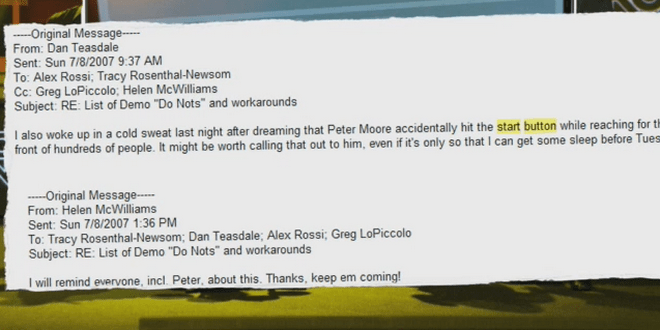
Teasdale didn’t travel to E3 that year, and was sitting on his couch with G4 on the TV when it came time for Rock Band to debut. As he predicted, tragedy struck. Moore accidentally paused the game in front of the thousands in attendance and many more watching remotely.
All Teasdale could do was cringe.
“I remember just curling into the fetal position on the couch for a good couple of minutes,” he said. “In the end, it didn’t matter and we won Game of Show, but having all of that anticipation and tension for the first reveal of your game turn into a punchline because we didn’t have time to add a ‘disable pause’ E3 demo cheat was rough.”
To Harmonix’s credit, the game was being played live, which is more than you can say for some E3 demos. The premiere got screwed up because they were being totally authentic.
A big stage demo at one of the big E3 press conferences in 2014, for example, was actually a video, a source told me. (I know what the game actually is, but agreed to keep it private, to protect my source’s identity.) They feared the game crashing, which happened the year before to Assassin’s Creed IV: Black Flag at Sony’s press conference. They didn’t want an unfinished game biting them in the arse.
If you don’t remember what happened to Assassin’s Creed IV: Black Flag, the video is below. I was in the audience when this happened and everyone was uncomfortable. You felt horrible.
You can understand why someone might want to avoid the same level of embarrassment.
“Before going on stage they played that demo hundreds of times over the weeks leading up to E3,” said a source close to the project.
“They didn’t practice the hand movements — they knew the demo frame perfect. I watched a few times live at the studio, and they had it down scarily well. However, the game at that point wasn’t perfect and if anything was slightly off, it wasn’t good enough for the E3 stage […] It was heartbreaking for them to have to use the video fallback, but the average fan doesn’t yet know what an unfinished game should look or feel like.”
Multiple developers involved with on-stage demos told me these fallback plans are common practice. Not every game is forced to use a fallback plan, but every game has one of them.
And that’s the quandary E3 demos find themselves in: having to present a false reality. The games are not done, yet they must pretend to be. This contradiction vexes even the most experienced developers.
The Danger of Promising Too Much
One of the most impressive E3 demos I’ve ever seen was BioShock Infinite‘s presentation from E3 2011. Shocking, suspenseful, thrilling — it was a masterful introduction to Columbia. About 20 developers at Irrational Games spent months hand-crafting this slick demo, despite the rest of the game being a state of disarray. (After several delays, it eventually shipped in March 2013.)
Here’s a refresher:
“The interesting thing was that the game reflected in that demo is not the game that we ultimately shipped,” said level designer Shawn Elliott, who contributed to its creation. He’s now at Arkane Studios.
What the demo provided for Irrational was an opportunity to crystalize what they wanted to build with BioShock Infinite. There were tentpoles in place already, but as has been reported in the past, it took a long time for BioShock Infinite to begin coalescing. For Elliott and the rest of the team, an E3 demo was an opportunity to prove the vision to themselves and players.
“The studio, led by Ken [Levine, head of Irrational], really knew that we wanted to use every single minute of trailer time — of that demonstration time — to communicate something significant about the game,” said Elliott. “And also to communicate it to ourselves.”
Just about everything in that demo was highly scripted. In other words, while someone was technically playing the game, they weren’t doing any improvising. They wanted to show the game off in a very specific way. Plus, at that point in development, that was the only option.
“AI [artificial intelligence], for instance, was just atrocious,” he said. “It was ungodly, unbelievably bad at that point in time. If you just let them loose, it would have been catastrophic.”
Scripting becomes a form of development “duct tape,” a phrase that was uttered to me several times by various game makers during my reporting for this story. Games — even those that ultimately turn out to be great — are broken for the vast majority of development, often coming together at the last second. Scripting is a way to compensate for game systems that hasn’t fully matured quite yet. At E3, some games may not ship for several months yet. In other cases, they may be years off.
To get a better idea of how this works, let’s go underneath the hood of an E3 demo. It’s been a few years since the humorous action series Destroy All Humans! was shown, but I was able to get my hands on the game’s E3 planning documents. These outline what the game’s developer, Pandemic, had to build for the demo, and what the presenters were being asked to do while showing it.
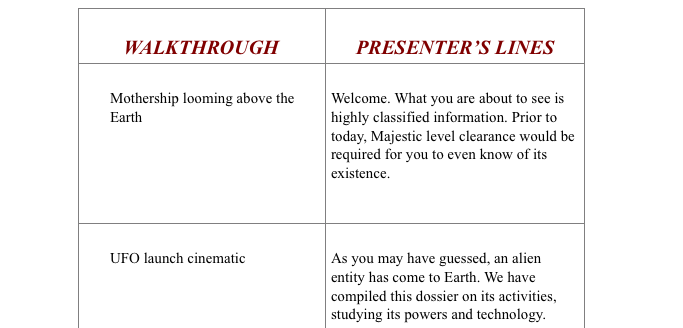
A document detailing every beat of the E3 demo is available for your perusal right here, and you can even compare it to the actual demo of Destroy All Humans! from E3 2004. While it’s not exactly word-for-word, there are definitely lines lifted from this script, and it follows the same flow.
The proper audio kicks in around 1:30.
You can go deeper, too. Want to know every animation that needed to be built for the demo? Read this document. Want to read the in-game script the developers used to build the demo? Read this.
For BioShock Infinite, the scripting was incredibly specific, down to when enemies fired a gun.
“If we were going to show the game at that state, for it to make any kind of good showing, we really needed to do [scripting],” said Elliott. “It would have been far more misleading to have the AIs doing what they’re naturally doing in that circumstance because, of course, we were going to improve that inevitably.”
But Elliott admitted the studio struggled with out to convey their ambition without promising a game they couldn’t deliver. While he’s proud of the demo — “it’s almost like a piece of cinema” — he admits it represented a version of the game that was slightly more idealistic.
Take, for example, a sequence in which Booker ditches Elizabeth to deal with a zeppelin that’s shown up in the area because his cover’s been blown. The game conveys a sprawling cityscape in which the zeppelin was summoned because the player had screwed up, and you’re forced to grapple with an entire city coming down on you because of a single mistake. It presented a version of BioShock Infinite more dynamic and open ended than what shipped.
“All that we legitimately hoped to deliver on,” he said.
When E3 was over, Irrational tried to get the demo running on consoles. Until then, most development had taken place on high-end PCs that could handle everything being dreamed up. The final game, however, had to ship on the rapidly ageing PlayStation 3 and Xbox 360.
“Due to memory constraints, it was like…uh oh,” laughed Elliott. “This is not going to happen.”
BioShock Infinite was hardly the first game to encounter this problem.
“During the PS2-era,” one anonymous developer told me, “I spent two months of incredibly intense crunch (on a one year project!) building a extremely impressive E3 demo. It like really stunning, groundbreaking stuff for the console. [I was] watching the final thing play out from start to finish in spectacular fashion, and right as the fade out kicks in, the lead engineer leans in behind me and whispers ‘you know, this’ll never run on an actual PS2, right?’”
For Irrational, this was when the project started coming back to Earth. All the “Best in Show” awards wouldn’t make the game suddenly run smoother on a console. Despite programmers working for months to improve performance, performance issues forced the team to alter its design. Elliott’s deeply proud of the of the game that went out the door, but admitted it was scaled back. Furthermore, the E3 demo wasn’t created with ill intent — that’s the game they wanted to build.

“No one was thinking ‘let’s just pull out all the stops, don’t worry about bullshitting, we need to make the best impression we possibly can and we’ll pay the piper afterwards,” he said. “In some ways, it was a terrible shock to many of the people. […] It doesn’t mean the consumer or enthusiast on a message board should go ‘oh, that’s fine.’ I understand perfectly — they’re in their right to be upset or concerned about it. The one thing I can say is the difference between someone who is malicious in their intent to deceive you from the get go and people running into very real constraints in the working conditions.”
One big change for BioShock Infinite was the amount of enemies on-screen at once. In the demo, there could be 16 characters running around, whereas the final game was restricted to six. That was a huge change, one whose ripple effect ran deeper than shifting polygon count.
“One necessary repercussion of that was so many enemies became much more sponge-y,” he said. “If you’ve got 16 guys, you can have them all die with a single hit.”
Changes happen. Most players will get that. For Elliott, part of the solution is transparency. Show the game as the players will experience it, he recommended, especially as project shifts from what you hope the game will be to the game actually showing up on Steam or Xbox Live.
“Be honest by showing people where you’re at,” he said.
Not Every Demo Gets People Excited For Your Game
BioShock Infinite was lavished with praise and awards. Sometimes, though, demos backfire.
When Splinter Cell: Blacklist was shown at E3 2012, fans were not pleased. They were pissed, actually. The E3 demo was full of guns and explosions, and featured little of the stealth gameplay the series was known for.
“We wanted to show that the game was bigger and offered additional play styles beyond stealth,” said a developer who worked on the game. “Since it always was a niche title, the hope was to attract new players to Splinter Cell. Unfortunately, when the existing fans saw the action base demo they were vocally upset, thinking we removed stealth.”
The demo wasn’t reflective of the game itself, as Splinter Cell: Blacklist would have plenty of options for stealth-minded players. But it forced the developers to spend additional work on the E3 demo after E3 to produce a version that showed a quieter approach to the mission.
Reusing a demo is common practice, however. Most developers hope to bring the same demo to E3, Gamescom, PAX, and whatever road show is required in the months after.
The on-stage Splinter Cell: Blacklist demo also illustrates a small detail most people would never notice. Since many demos are scripted affairs, often there little built beyond the scope of the demo itself. There’s no expectation the player is going to wander off, so there’s literally nothing beyond what the demo literally has to show. No enemies, no buildings, no skyline.
When somebody is playing a game for a press conference, even the directions where they’re going to move the camera are carefully considered and rehearsed ahead of time.
“The demos follow the ‘golden path,’ which means every camera movement is planned out and practiced,” said one developer. “If you know what to look for, it will stand out like a sore thumb.”
During the demo, one of the developers deviated from the script, which caused the studio watching at home to audibly gasp and worry it was all going to fall apart. Thankfully, it didn’t.
Other times, developers hope bugs they weren’t able to squash manage to hide themselves. This problem had Tomb Raider level designer Andrew Dovichi on the edge of his set in 2012.
“There is a section at the end where Lara jumps a gap,” he said, “crashes hard on the other side and begins to slide towards the edge, barely grabbing on at the last second while hanging over a chasm. During this bit, she drops her torch on the ground while trying to scramble and the torch is supposed to slide down with her and then tumbles into the chasm. Very rarely, the torch would actually get stuck on some geometry in front of Lara and not tumble down the chasm. Such a trivial and stupid thing in retrospect, but we just knew it was going to happen during the stage demo so we were all holding our breath watching.”
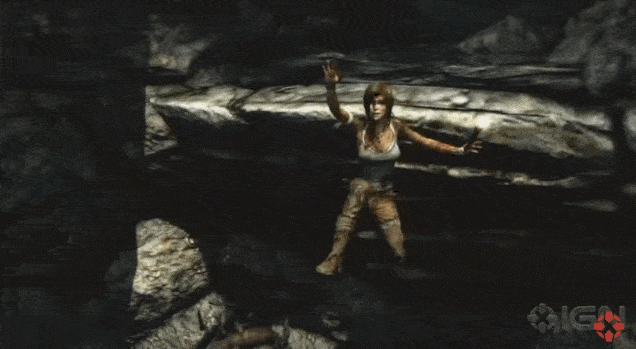
As it turned out, the torch tumbled just fine.
Other times, the screw up isn’t even your fault.
“One year we kept having a game crash and couldn’t figure out why,” said a developer. “We got new builds sent to us every few hours from the office to try and fix it, and it still kept happening. Turns out the PlayStation was overheating in the tiny little cupboards we had to store it in. Oops!”
Planning is integral to the overall process because demos — E3 or otherwise — are not simply levels plucked out of the main game. E3 demos have to represent what the game will eventually look like, not what it looks like right now; these games aren’t done yet. And so games at E3 are forced to balance between ambition, promise, and reality at the same time.
Massive Development Distraction, Valuable Focusing Tool
Making these demo also means some folks are stepping away from building the game itself. Developers I talked to were split on what impact developing an E3 demo has on a team.
“From a pure development point-of-view, an E3 demo tends to be a massive distraction,” said designer Sam Bass, who’s worked on E3 demos for nearly 20 years, including Star Wars: Force Commander, Medal of Honour: Rising Sun, Goldeneye: Rogue Agent, and many others. “You are derailing a good chunk of your team for 1-2 months of what is often essential development time and often leaving them pretty burnt out after the fact.”
“As a staff dev or a senior, I always hated E3 demos because they pulled from our focus of making and shipping the main game,” said Dan Teasdale, formerly of Harmonix. “As a lead, I didn’t mind them because they acted as a forcing function to bring the game to another level or set a quality bar for the rest of the game, and provided a ton of direction feedback from the outside world without having to release your game in the wild.”
More and more game developers are trying to bake the process of making demos into their schedule ahead of time, and hopefully avoid the problem of creating meaningless content.
“Avoiding wasted work is a pretty important factor in creating the demo,” said one anonymous developer. “Nine times out of 10 we will change the demo, rather than create custom demo assets. I think that goes a long way to making the process not feel like a distraction or waste of time. Everything in our demos remain intact in the final game.”
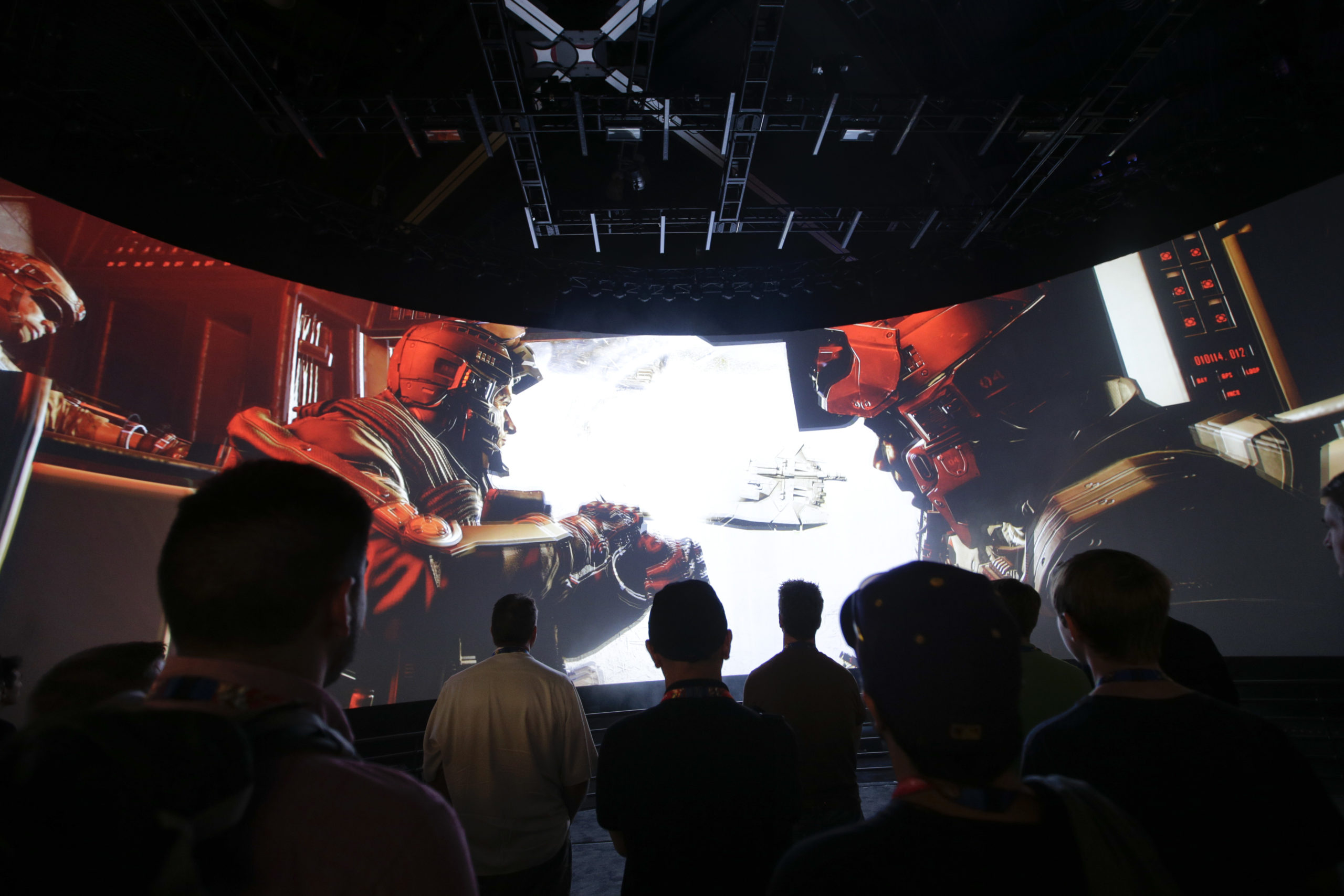
Managing waste, especially for teams releasing games later that year, is critical to morale.
“Nobody likes to spend dozens or hundreds of hours of their life working on content that is just going to get cut,” said Dovichi. “That is just plain demoralising and is a great way to foster resentment in your team.”
The best laid plans often go awry, however.
One anonymous developer told me about an intense crunch period spent on a “big AAA franchise” that had most of the team working 12 hours a day, seven days a week, for a while.
“One Sunday, we were all crunching away, when our executive producer rolled up from the golf course to see how ‘his boys’ were doing, family in tow,” they said. “He stuck around just long enough for everyone to know he hadn’t been in-office that entire time, nab a burrito from the crunch pile and take off. I am amazed he made it out of the building alive.”
Ouch.
E3 demos are about selling you a product. They’re advertising. Video games may be art, but they want your money, too. It’s a delicate balance, but every developer told me they wanted nothing more than to make players happy. Sometimes, that has a cost. Everything does.
“We know deep inside that the game usually doesn’t match the hyperbole at E3,” said one anonymous developer. “But, then again, we had to lay the hyperbole on thick when we first pitched it to the publisher, and then again when we pitched it internally to the dev team, and then again when we talk about it to the press. I genuinely don’t believe we’re being purposely deceptive here. Perhaps a tad naive and in denial, but it comes from a place of genuine care about the game and us just wanting to see the best for it. Like a parent trying to get their kid into a prestigious college, perhaps. Hoping their lazy brat of a kid will get themselves into shape by the time class starts, because they can see the potential.”
Next week, the cycle begins anew.
This article has been retimed since its original publication.
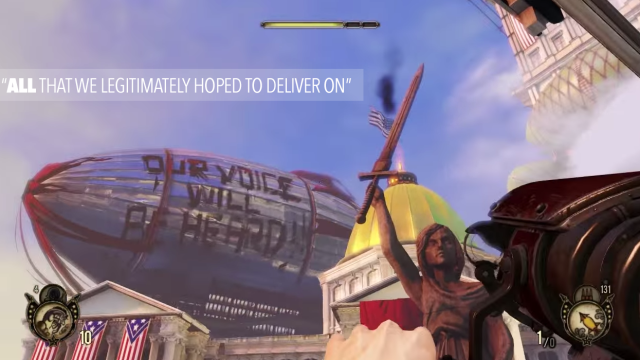
Comments
11 responses to “The Real Stories Behind E3’s Glossy Game Demos”
It’s a sad state of affairs that I’ve come to not trust gameplay demos even when you are told they are ‘totes real!’. I just hope that what I end up getting looks/plays as well and its always a case of pay attention to gameplay videos closer to release that are running on closer to final code.
This.
I use E3 to see what looks interesting at the time, but if it is something I’m interested in, I’m going to check out gameplay videos before I pay any ridiculously overinflated Australia price.
Great article Patrick.
Yeah I signed in just to say this. Really well researched and laid out, superb journalism.
Unless a game is in the final stages of development (hopefully with Fallout 4 being mere months away if the rumours are true then what we’ll see from Bethesda will be largely accurate to in game), then I take what I see at E3 with a pinch of salt. I remember watching the Infinite videos and thinking ‘this really is carrying the torch on from the first Bioshock’. I felt let down with the final product which, while still great, wasn’t what was advertised.
I’ve always wondered though when you see someone with a controller in hand on stage if they’re actually playing or not
That reminds me of my favourite E3 reveal of all time.
When they first showed Half-Life 2 at E3 it was a HUGE deal, was in a very advanced stage and looked goddam AMAZING!
The announcement that it was only a few months away just blew my mind.
Then some pricks stole the (near finished) code and the game got delayed significantly…..
Call me a sucker (I am) but I still get a little bit excited every E3 that a near-finished HL3 will pop out of nowhere.
Will be interesting to see whats on show this year. Especially Ubisoft. Wait, who wasn’t invited to that one?
It seems seeing is not necessary believing nowadays.
The splinter cell demo seemed pretty damn close to what was in the actual game. Great game too!
“When E3 was over, Irrational tried to get the demo running on consoles. Until then, most development had taken place on high-end PCs that could handle everything being dreamed up. The final game, however, had to ship on the rapidly ageing PlayStation 3 and Xbox 360.”
RRRrrrrrrr…
This just got me thinking of that Watch_Dogs E3 demo. That was incredible! But the post-launch reviews of the game have meant that I haven’t played it yet. Still over $20.